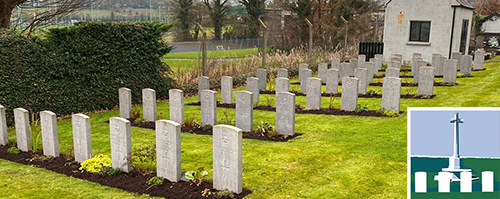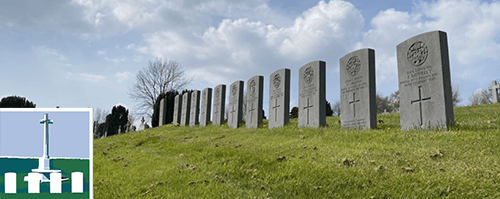Belfast City Cemetery
During both World Wars Belfast was an important hub of military activity. The port was busy with Merchant Navy and Royal Navy ships, and it was from here that many service personnel left Ireland to serve overseas. Many of the service burials in this cemetery were made by local people who chose to lay their fallen loved one to rest here. Other burials came from one of several military hospitals which were established in the city. Today, this is the final resting place of almost 600 Commonwealth service personnel, the largest number in Northern Ireland.

Opened in 1869, Belfast City Cemetery is one of the oldest and largest public cemeteries in Belfast. Amongst the 225,000 civilian burials here are 570 Commonwealth servicemen and women of the two World Wars, including five who remain unidentified, the largest number of Commonwealth war graves in Northern Ireland. You will find war graves throughout this large war cemetery, the majority however are concentrated in three war graves plots. Within Plot H stands a Screen Wall Memorial which bears the names of 140 service personnel. These men were buried in common graves so today their graves cannot be individually marked with a headstone. In addition to the Commonwealth war graves, there are three sailors of the Norwegian Merchant Navy who died during the second World War buried in the cemetery.
Find out more
The 570 Commonwealth servicemen and women buried in Belfast City Cemetery reflect the city’s maritime and military heritage during the two World Wars.
Belfast was home to the regimental headquarters of the Royal Irish Rifles (later renamed Royal Ulster Rifles) and 100 men of the regiment are buried in Belfast City Cemetery. During the First World War, men of Belfast volunteered in their tens of thousands for service with the British armed forces. Many were members of the Ulster Volunteer Force (UVF) and went on to serve with distinction with the 36th (Ulster) Division. The 36th (Ulster) Division served on the Western Front and saw their first major action on 1 July 1916, the first day of the Battle of the Somme. Other Belfast men volunteered or were already serving with the Royal Navy and saw service around the world during both World Wars.

Members of the Ulster Volunteer Force march through Belfast, shortly before the First World War. © IWM Q 81771
While some men went off to fight in the First World War from 1914, others laboured in Belfast’s industries alongside women, manufacturing weapons, ammunition, and other war material. One Belfast firm, James Mackie & Sons of Belfast, produced an estimated 75 million shells during the War. Most notable, however, was Belfast’s shipbuilding industry, which employed some 37,000 workers during the War. Home to the famous Harland and Wolff, builders of the RMS Titanic, hundreds of Royal Navy warships were built and repaired in Belfast’s docks.
Belfast was also home to eight military hospitals which cared for sick and wounded service personnel during the First World War. Nurse Gertrude Annie Taylor of the Voluntary Aid Detachments served at the UVF Hospital, which was established at Botanic Gardens with support from the UVF, and later expanded to the grounds of Queen's University. Daughter of Mr A. Taylor of Strandtown, Belfast, Gertrude went on to serve at Hospitals in France and London where she died of pneumonia on 12th December 1916, aged 35. She was buried in Belfast City Cemetery (grave L. 391.). A sermon given by the Minister of Belmont Presbyterian Church, the Reverend MacDermott, on 17 December 1917 paid tribute to Gertrude:
“Miss Taylor’s death reminds us that not all the heroes in the war were men; they were not all to be found among the fighters at the front. Not infrequently they were to be found among those who, all unmentioned, faithfully performed their duties at the bedsides of the wounded and weary. For them there was no roar of the guns, no excitement of the charge—nothing but the endless battle against suffering and death; but they were heroes and heroines all the same.”

Nurse Gertrude Annie Taylor, Voluntary Aid Detachments © IWM WWC H2-127
During the Second World War, men and women of Belfast again rose to the task and served in the armed forces or laboured in the shipping & other industries vital to the war effort. However, the changing nature of warfare meant that Belfast was now a target for German air raids. In April and May 1941, the city was bombed by the German Luftwaffe (Air Force) in what became known as the ‘Belfast Blitz’.

View of the Musgrave Channel, Belfast showing HMS ONTARIO (near left) and HMS WIDEMOUTH BAY (right) - © IWM A 28024
The first raid on the night of 7/8 April 1941 was comparatively light, but the following raid on 15 April 1941 resulted in the deaths of over 800 people – the greatest loss of life in any night raid outside of London during the Blitz. The city was then attacked for a third and fourth time over two nights on 4 and 5 May. On 5 May, Campbell College, Belfast, which was home to 20 and 24 General Hospitals, was hit. 19 people died when bombs hit the college. Four members of the Royal Army Medical Corps, including Major Richard Ward of Ipswich, Suffolk, were killed. They are buried side-by-side in Belfast City cemetery (Glenalina Extn. Sec. A.S. Grave 99- 102.) along with 30 other servicemen who died in April and May 1941, the majority of whom were also killed as a result of the German air raids.

Rescue workers search through the rubble of Eglington Street in Belfast, Northern Ireland after a German Luftwaffe air raid, 7 May 1941. - © IWM H 9476
In total, over 1,300 houses were demolished and tens of thousands damaged as a result of the Belfast Blitz. The CWGC Civilian Roll of Honour records the names of 850 civilians of Belfast who died in April and May 1941.
Visit Belfast City Cemetery
Before visiting we recommend you consult the website of the cemetery authority.

This small town in County Fermanagh holds the largest group of Second World War air force dead in all of Northern Ireland. The final resting place of 74 young airmen from across the Commonwealth.
Irvinestown Church of Ireland Churchyard
Londonderry City Cemetery was opened in 1853. Amongst the 70,000 civilian burials are 194 Commonwealth war graves of the First and Second World War.
Londonderry (Derry) City Cemetery



